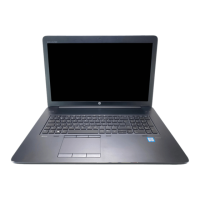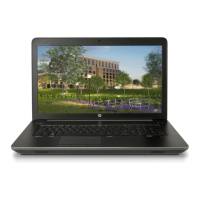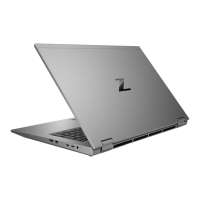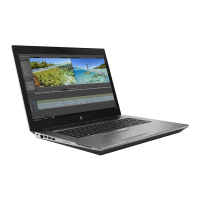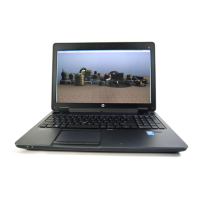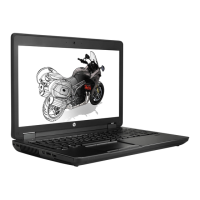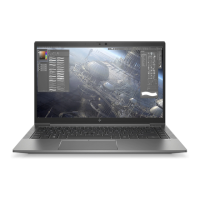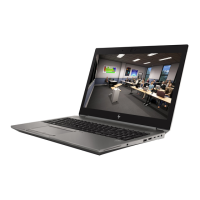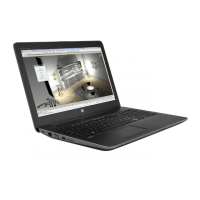Do you have a question about the HP ZBook 17 G2 and is the answer not in the manual?
Details on the various Intel Core processors supported by the workstation, including clock speed and cache.
Information on supported graphics subsystem boards, including OpenGL driver support and display capabilities.
Specifications for the display panel, including aspect ratio, resolution, and backlight technology.
Details on memory slots, supported RAM types, capacities, and common configurations.
Information on supported hard drives and solid-state drives for primary storage.
Details on storage options and optical drives that can be installed in the upgrade bay.
Overview of the computer's ports, including USB, DisplayPort, and docking connectors.
List of preinstalled operating systems and supported restore media options.
Lists parts that can be replaced by the end-user.
Identifies external display components like WLAN/WWAN antennas and webcam.
Locates and describes the power button, speakers, wireless button, and fingerprint reader.
Identifies keys like ESC, FN, Windows button, and function keys.
Explains the function of various indicator lights like power, caps lock, and wireless.
Details the pointing stick, touchpad buttons, and touchpad zone.
Identifies components on the front of the computer, including lights and drive indicators.
Locates and describes ports on the left side, such as USB, DisplayPort, and Thunderbolt.
Identifies components on the right side, including memory card reader and optical drive.
Locates and describes rear components like the network jack and power connector.
Identifies bottom components like battery release, SIM slot, and docking connector.
Explains the importance of the service tag for ordering parts and requesting information.
Describes the PCID label's role in resetting notebook firmware to factory specifications.
Provides a breakdown of major computer components and their spare part numbers.
Details the individual parts that make up the display assembly.
Lists components included in the bracket kit for mounting.
Identifies the cables included in the kit for connecting various internal components.
Lists plastic parts such as bezels and covers included in the kit.
Details specifications and spare part numbers for solid-state and hard drives.
Lists various accessories and parts not categorized elsewhere, like AC adapters and mice.
Provides a cross-reference of spare part numbers to their descriptions.
Lists the necessary tools for performing disassembly and reassembly procedures.
Provides general advice and notes for handling components during service.
Offers guidance on handling plastic parts to prevent damage during service.
Advises on careful handling of cables and connectors to avoid damage.
Details essential precautions for handling fragile storage drives.
Explains procedures for grounding to prevent electrostatic discharge damage.
Describes the sensitivity of electronic components to ESD and potential damage.
Provides instructions for safely packaging and transporting computer components.
Offers recommendations for setting up a safe and effective service workstation.
Details grounding equipment requirements for preventing electrostatic damage.
Introduces procedures for replacing customer-accessible parts.
Step-by-step instructions for removing and replacing the computer battery.
Procedure for removing and installing the SIM card.
Instructions for removing the service cover to access internal components.
Detailed steps for removing and replacing primary and secondary hard drives.
Procedure for removing and installing solid-state drives.
Instructions for removing and installing the Wireless Local Area Network module.
Procedure for removing and installing the Wireless Wide Area Network module.
Steps for removing and replacing the Real-Time Clock battery.
Instructions for removing and installing the optical drive.
Procedure for installing or removing a hard drive in the upgrade bay.
Steps for adding or replacing expansion memory modules.
Detailed procedure for removing and installing the keyboard.
Instructions for replacing primary memory modules.
Introduces procedures for parts accessible only by authorized service providers.
Step-by-step guide to remove and replace the display bezel.
Instructions for removing and installing the display panel.
Procedure for removing and replacing the webcam and microphone module.
Detailed steps for removing and replacing the top cover.
Instructions for removing and installing the multifunction board.
Procedure for removing and replacing the speaker assembly.
Steps for removing and installing the fingerprint reader module.
Procedure for removing and replacing the power button board.
Instructions for removing the entire display assembly from the computer.
Procedure for removing and installing the ExpressCard assembly.
Steps for removing and installing the smart card reader.
Procedure for removing and installing the audio/USB board.
Instructions for removing and installing the processor heat sink.
Steps for removing and installing the graphics subsystem heat sink.
Procedure for removing and installing the graphics board.
Instructions for removing and installing the power connector cable.
Detailed steps for removing and installing the system board.
Overview of Computer Setup (BIOS) functionality and its role in system configuration.
Instructions on how to access the Computer Setup utility.
Guidance on navigating menus and making selections within Computer Setup.
Steps to return BIOS settings to their factory default values.
How to find the current BIOS version for update purposes.
Instructions for safely downloading and installing BIOS updates.
Information on managing boot device order and preferences.
Details on running hardware diagnostic tests for troubleshooting.
Overview of Computer Setup (BIOS) functionality for system configuration.
Instructions on how to access the Computer Setup utility.
Guidance on navigating menus and making selections within Computer Setup.
Steps to return BIOS settings to their factory default values.
How to find the current BIOS version for update purposes.
Instructions for safely downloading and installing BIOS updates.
Information on managing boot device order and preferences.
Guide to running hardware diagnostics using HP PC Hardware Diagnostics UEFI.
Instructions on how to access the Computer Setup utility in SUSE Linux.
Guidance on navigating menus and making selections within Computer Setup.
Steps to return BIOS settings to their factory default values.
How to find the current BIOS version for update purposes.
Instructions for safely downloading and installing BIOS updates.
Details on running hardware diagnostic tests for troubleshooting in Linux.
Provides detailed technical specifications for the computer's hardware and dimensions.
Guidance on creating system repair media and performing backups.
Information on using recovery tools to restore the computer.
Instructions for using f11 recovery tools to restore the hard drive image.
Steps for performing recovery using Windows 8 OS media.
Guide to using Windows Refresh for quick system recovery without data loss.
Procedure to reset the computer to its original state, removing all data.
Instructions for reinstalling drivers or software using HP Software Setup.
Guidance on creating recovery media and performing system backups.
Important notes regarding disc types and power connection for media creation.
Steps to create recovery media using the HP Recovery Disc Creator utility.
Recommendations for backing up personal files and system settings.
Information on using recovery tools to restore the computer's system.
Details on using Windows recovery tools for files, restore points, and startup repair.
Instructions for using f11 recovery tools to restore the original hard drive image.
Steps for performing recovery using Windows 7 OS media.
Guidance on creating restore media and performing regular system backups.
Steps to create HP Factory Image for system recovery.
Recommendations for backing up computer files to external drives or discs.
Instructions for restoring the computer to its original factory state.
Procedure to reformat and reinstall the Linux operating system.
Details on nonvolatile memory types, their purpose, and data protection.
FAQs covering BIOS settings restoration, UEFI BIOS, and data erasure.
Information on HP Sure Start, a BIOS protection and recovery technology.
General requirements for power cord sets, including length and current capacity.
Country-specific requirements and certifications for power cord sets.
Details on the various Intel Core processors supported by the workstation, including clock speed and cache.
Information on supported graphics subsystem boards, including OpenGL driver support and display capabilities.
Specifications for the display panel, including aspect ratio, resolution, and backlight technology.
Details on memory slots, supported RAM types, capacities, and common configurations.
Information on supported hard drives and solid-state drives for primary storage.
Details on storage options and optical drives that can be installed in the upgrade bay.
Overview of the computer's ports, including USB, DisplayPort, and docking connectors.
List of preinstalled operating systems and supported restore media options.
Lists parts that can be replaced by the end-user.
Identifies external display components like WLAN/WWAN antennas and webcam.
Locates and describes the power button, speakers, wireless button, and fingerprint reader.
Identifies keys like ESC, FN, Windows button, and function keys.
Explains the function of various indicator lights like power, caps lock, and wireless.
Details the pointing stick, touchpad buttons, and touchpad zone.
Identifies components on the front of the computer, including lights and drive indicators.
Locates and describes ports on the left side, such as USB, DisplayPort, and Thunderbolt.
Identifies components on the right side, including memory card reader and optical drive.
Locates and describes rear components like the network jack and power connector.
Identifies bottom components like battery release, SIM slot, and docking connector.
Explains the importance of the service tag for ordering parts and requesting information.
Describes the PCID label's role in resetting notebook firmware to factory specifications.
Provides a breakdown of major computer components and their spare part numbers.
Details the individual parts that make up the display assembly.
Lists components included in the bracket kit for mounting.
Identifies the cables included in the kit for connecting various internal components.
Lists plastic parts such as bezels and covers included in the kit.
Details specifications and spare part numbers for solid-state and hard drives.
Lists various accessories and parts not categorized elsewhere, like AC adapters and mice.
Provides a cross-reference of spare part numbers to their descriptions.
Lists the necessary tools for performing disassembly and reassembly procedures.
Provides general advice and notes for handling components during service.
Offers guidance on handling plastic parts to prevent damage during service.
Advises on careful handling of cables and connectors to avoid damage.
Details essential precautions for handling fragile storage drives.
Explains procedures for grounding to prevent electrostatic discharge damage.
Describes the sensitivity of electronic components to ESD and potential damage.
Provides instructions for safely packaging and transporting computer components.
Offers recommendations for setting up a safe and effective service workstation.
Details grounding equipment requirements for preventing electrostatic damage.
Introduces procedures for replacing customer-accessible parts.
Step-by-step instructions for removing and replacing the computer battery.
Procedure for removing and installing the SIM card.
Instructions for removing the service cover to access internal components.
Detailed steps for removing and replacing primary and secondary hard drives.
Procedure for removing and installing solid-state drives.
Instructions for removing and installing the Wireless Local Area Network module.
Procedure for removing and installing the Wireless Wide Area Network module.
Steps for removing and replacing the Real-Time Clock battery.
Instructions for removing and installing the optical drive.
Procedure for installing or removing a hard drive in the upgrade bay.
Steps for adding or replacing expansion memory modules.
Detailed procedure for removing and installing the keyboard.
Instructions for replacing primary memory modules.
Introduces procedures for parts accessible only by authorized service providers.
Step-by-step guide to remove and replace the display bezel.
Instructions for removing and installing the display panel.
Procedure for removing and replacing the webcam and microphone module.
Detailed steps for removing and replacing the top cover.
Instructions for removing and installing the multifunction board.
Procedure for removing and replacing the speaker assembly.
Steps for removing and installing the fingerprint reader module.
Procedure for removing and replacing the power button board.
Instructions for removing the entire display assembly from the computer.
Procedure for removing and installing the ExpressCard assembly.
Steps for removing and installing the smart card reader.
Procedure for removing and installing the audio/USB board.
Instructions for removing and installing the processor heat sink.
Steps for removing and installing the graphics subsystem heat sink.
Procedure for removing and installing the graphics board.
Instructions for removing and installing the power connector cable.
Detailed steps for removing and installing the system board.
Overview of Computer Setup (BIOS) functionality and its role in system configuration.
Instructions on how to access the Computer Setup utility.
Guidance on navigating menus and making selections within Computer Setup.
Steps to return BIOS settings to their factory default values.
How to find the current BIOS version for update purposes.
Instructions for safely downloading and installing BIOS updates.
Information on managing boot device order and preferences.
Details on running hardware diagnostic tests for troubleshooting.
Overview of Computer Setup (BIOS) functionality for system configuration.
Instructions on how to access the Computer Setup utility.
Guidance on navigating menus and making selections within Computer Setup.
Steps to return BIOS settings to their factory default values.
How to find the current BIOS version for update purposes.
Instructions for safely downloading and installing BIOS updates.
Information on managing boot device order and preferences.
Guide to running hardware diagnostics using HP PC Hardware Diagnostics UEFI.
Instructions on how to access the Computer Setup utility in SUSE Linux.
Guidance on navigating menus and making selections within Computer Setup.
Steps to return BIOS settings to their factory default values.
How to find the current BIOS version for update purposes.
Instructions for safely downloading and installing BIOS updates.
Details on running hardware diagnostic tests for troubleshooting in Linux.
Provides detailed technical specifications for the computer's hardware and dimensions.
Guidance on creating system repair media and performing backups.
Information on using recovery tools to restore the computer.
Instructions for using f11 recovery tools to restore the hard drive image.
Steps for performing recovery using Windows 8 OS media.
Guide to using Windows Refresh for quick system recovery without data loss.
Procedure to reset the computer to its original state, removing all data.
Instructions for reinstalling drivers or software using HP Software Setup.
Guidance on creating recovery media and performing system backups.
Important notes regarding disc types and power connection for media creation.
Steps to create recovery media using the HP Recovery Disc Creator utility.
Recommendations for backing up personal files and system settings.
Information on using recovery tools to restore the computer's system.
Details on using Windows recovery tools for files, restore points, and startup repair.
Instructions for using f11 recovery tools to restore the original hard drive image.
Steps for performing recovery using Windows 7 OS media.
Guidance on creating restore media and performing regular system backups.
Steps to create HP Factory Image for system recovery.
Recommendations for backing up computer files to external drives or discs.
Instructions for restoring the computer to its original factory state.
Procedure to reformat and reinstall the Linux operating system.
Details on nonvolatile memory types, their purpose, and data protection.
FAQs covering BIOS settings restoration, UEFI BIOS, and data erasure.
Information on HP Sure Start, a BIOS protection and recovery technology.
General requirements for power cord sets, including length and current capacity.
Country-specific requirements and certifications for power cord sets.
| Form factor | Clamshell |
|---|---|
| Product type | Mobile workstation |
| Product color | Black |
| Country of origin | China |
| Bus type | DMI |
| Stepping | C0 |
| Tjunction | 100 °C |
| Processor cache | 6 MB |
| Processor cores | 4 |
| Processor model | i7-4710MQ |
| System bus rate | 5 GT/s |
| Processor family | Intel® Core™ i7 |
| Processor series | Intel Core i7-4700 Mobile series |
| Processor socket | PGA946 |
| Processor threads | 8 |
| Processor codename | Haswell |
| Processor frequency | 2.5 GHz |
| Processor cache type | Smart Cache |
| Processor lithography | 22 nm |
| Processor manufacturer | Intel |
| Processor front side bus | - MHz |
| PCI Express slots version | 3.0 |
| Processor boost frequency | 3.5 GHz |
| Processor operating modes | 64-bit |
| ECC supported by processor | No |
| PCI Express configurations | 1x16, 2x8, 1x8+2x4 |
| Thermal Design Power (TDP) | 47 W |
| Maximum number of PCI Express lanes | 16 |
| Motherboard chipset | Intel® QM87 |
| Memory slots | 4x SO-DIMM |
| Internal memory | 4 GB |
| Memory clock speed | 1600 MHz |
| Internal memory type | DDR3L-SDRAM |
| Maximum internal memory | 32 GB |
| Memory layout (slots x size) | 1 x 4 GB |
| HDD speed | 7200 RPM |
| HDD interface | SATA |
| Storage media | HDD |
| Optical drive type | DVD Super Multi DL |
| Card reader integrated | Yes |
| Total storage capacity | 500 GB |
| Compatible memory cards | SD, SDHC, SDXC |
| Number of HDDs installed | 1 |
| Display surface | - |
| Display diagonal | 17.3 \ |
| Display resolution | 1600 x 900 pixels |
| Native aspect ratio | 16:9 |
| On-board graphics card ID | 0x416 |
| Discrete graphics card model | NVIDIA® Quadro® K1100M |
| On-board graphics card model | Intel® HD Graphics 4600 |
| Discrete graphics card memory | 2 GB |
| Discrete graphics memory type | GDDR5 |
| On-board graphics card family | Intel® HD Graphics |
| Maximum on-board graphics card memory | 1.74 GB |
| On-board graphics card base frequency | 400 MHz |
| On-board graphics card DirectX version | 11.2/12 |
| On-board graphics card dynamic frequency (max) | 1150 MHz |
| Audio system | DTS Studio Sound |
| Number of built-in speakers | 2 |
| Wi-Fi standards | Wi-Fi 5 (802.11ac) |
| Bluetooth version | 4.0 |
| Ethernet LAN data rates | 10, 100, 1000 Mbit/s |
| Charging port type | DC-in jack |
| HDMI ports quantity | 0 |
| USB 2.0 ports quantity | USB 2.0 ports have a data transmission speed of 480 Mbps, and are backwards compatible with USB 1.1 ports. You can connect all kinds of peripheral devices to them. |
| USB 3.2 Gen 1 (3.1 Gen 1) Type-A ports quantity | 3 |
| Pointing device | Touchpad |
| Recovery operating system | Windows 8.1 Pro |
| Operating system installed | Windows 7 Professional |
| Processor code | SR1PQ |
| Processor ARK ID | 78931 |
| Intel TSX-NI version | 0.00 |
| Processor package size | 37.5 x 32 x 1.6 mm |
| Supported instruction sets | AVX 2.0, SSE4.1, SSE4.2 |
| Intel Identity Protection Technology version | 1.00 |
| Battery capacity | 75 Wh |
| Battery life (max) | - h |
| AC adapter power | 200 W |
| Sustainability certificates | ENERGY STAR |
| Depth | 272 mm |
|---|---|
| Width | 416 mm |
| Height | 34 mm |
| Weight | 3410 g |
